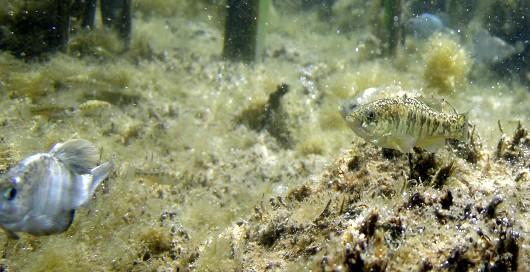Owens Pupfish
-
Scientific NameCyprinodon radiosus
-
NativeYes
-
Identification
 Owens pupfish, male. Location: Fish Slough, CA. Photo by Joe Ferreira, California Department of Fish and Game.
Owens pupfish, male. Location: Fish Slough, CA. Photo by Joe Ferreira, California Department of Fish and Game. Owens pupfish, male (blue) and female (brown). Photo by Stacey Brown, MD. If you look closely you can find at least 5 additional females and 3 males.
Owens pupfish, male (blue) and female (brown). Photo by Stacey Brown, MD. If you look closely you can find at least 5 additional females and 3 males.- Small, deep bodied, up to 65 mm TL
- Large eyes, terminal mouth, protrusible lips
- Large scales, spines absent on circuli, interspaces between circuli reticulated
- First dorsal ray thick, equidistant from base of tail and tip of snout
- Sexual dimorphism present: males larger and deeper bodied
- Breeding males: bright blue, purple lateral bars
- Females: olive brown with purple sheen, lateral blotches and bars present
- Fin rays: dorsal 10-12, anal 9-12, pectoral 13-17, pelvic 6-8, caudal 16-19
- Lateral series scales: 26-27
-
Life History
Owens Pupfish historically occupied a variety of shallow water locations in the Owens Valley. Typical waters included spring pools, sloughs, and irrigation ditches. Such water bodies were characterized by shallow clear water, and by the presence of emergent and aquatic vegetation. Historical water temperatures probably ranged from 10 to 25°C and associated species would have included Owens Speckled Dace, Owens Tui Chub, and Owens Suckers. Today Owens Pupfish are found in a limited number of refuges where the water is clear and primarily shallow, and where predators are limited. They forage in shoals of 30-50 fish, feeding mostly on aquatic organisms like crustaceans, snails, chironomid midge larvae, etc. During the nighttime and winter months pupfish are sedentary and rest on or in the substrate. Within one year Owens Pupfish reach adult size and begin breeding, rarely living more than two years total. Spawning seasons vary between locations. In some places spawning might begin in February and end by late June but in locations affected by large seasonal temperature fluctuations spawning typically begins in March and lasts through August. Spawning behavior involves both courtship and competition. Non-territorial males might initiate breeding while territorial males stick to a specific area near shore. Females remain under the cover of vegetation till they are ready to spawn, and spawning commences over different kinds of substrate including silt, plants, or rocks. Female Owens Pupfish may engage with a potential mate up to 200 times in one day, though 60-70% of courtship fails to result in an egg. A successful spawn results in 1 or 2 fertilized eggs. The eggs hatch in 4-10 days at 24-27°C. Emerging larvae and subsequent juveniles tend to remain close to the stream substrate.
-
Links to Other ResearchN / A

